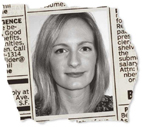“You might have great email conversations, you might have some great phone conversations, but you meet and there might be no chemistry,” she continued. “You need to be friends; you need to have a relationship. If you don’t have chemistry it’s hard to trust them. As a print buyer you’re trusting them with your career and brand, so it has to work.”
With this in mind, Sletten’s emphasis on how important clicking with a prospective customer is, actually makes a lot of sense. But as simple as doing so may sound, it’s likely many in print may now be struggling.
“The average marketer buying print is now probably 27 and female, and the average print company boss is 47 to 54 and male,” reports print consultant Neil Falconer. “If you talk to most print companies, they don’t see the value of social media and LinkedIn. They’ve had 25 years of talking product and machinery and it’s a chasm, because this is a completely different generation of print buyer.”
Printers need to realise that the days of the press-pass-attending, old-school buyer, whose sole responsibility was procuring print and who probably had an extensive background and expertise here, are long gone. The march of technology, recession and the digital age have all had an impact, explains BPIF chief executive Kathy Woodward.
“Partly it was the recession; you’ve always had this balance of power between marketing and purchasing,” she says. “And in a recession it’s all about cost management. So purchasing started to take the upper hand and people started looking at ‘how can we get more from our marketing spend?’, and more at innovation. If you put that alongside online transformation, that’s created a whole different organisational structure in your marketing department.”
“And the colour management systems and pre press advances have taken a lot of the mystique and skillset of that role away. The buyer no longer needs to be a highly paid person to ensure that,” she continues, adding: “That’s enabled a different sort of person to move into those roles. Most will be media graduates who have graduated in the past few years; so we’re definitely looking at a younger demographic.”
Different priorities
With this new print buyer a completely different individual to the print buyer of old, with a completely different set of priorities and responsibilities, it stands to reason their job title will have radically altered too. And it’s not just office managers, graphic designers and marketing managers printers must now seek out. Today’s printer must contend with a rising trend for what can seem, to the uninitiated, bafflingly obscure job descriptions.
“The top ten jobs in 2012/13 didn’t exist in 2007. So we’ve now got sustainability officers, we’ve got chief data mining executives, we’ve got chief listening officers all ordering print,” says Falconer, reporting that this can make identifying the right person to talk to somewhat fraught.
“I met someone recently who was buying print but the next week his assignment would be buying something else,” adds Woodward. “And I recently saw a job ad in marketing trade title for a ‘comms executive’. Nowhere in the job title did it say it was print buying, but when you actually read the job description, it was about targeted document management.”
Falconer adds that there are now more often a number of individuals influencing print ordering. To be effective, a printer may need to court them all.
“Now you’ve got different buying influences: you’ve got the commercial director, the finance director, a CEO, someone who’s buying print, and it’s ‘what can we find there for everybody?’ If you’re just talking to the procurement person you’re probably talking to the wrong guy.”
Then there’s the boom in start-ups to consider. Now able to do more with less thanks to e-commerce, one-man bands and micro-firms are an increasingly important part of the UK business landscape. With the number of new businesses established growing every year, and 49% of small businesses setting up with less than £2,000, a new breed of micro-business is coming through – headed by someone a lot younger than perhaps might be expected and juggling a lot of other responsibilities other than just ordering print.
So how can printers best connect with this new generation of buyer? For Woodward, it’s about making technical print processes easy to work with and not bogging the buyer down with irrelevant technical detail.
“Buyers aren’t particularly interested in what press it’s been printed on or the process – they want the operation flow of the data explained as simply and as robustly as possible,” she reports.
To make an impression, printers need to speak the print buyer’s language, adds Falconer. And that language is digital.
“Today’s print buyer has a whole range of channels they’re used to working with. They work with them in their personal life, they work with them in their professional life,” he says. “And not enough print companies use those channels in their own marketing.”
Printers need, then, to take time to re-acquaint themselves with their print buyer. As with any relationship, putting in the time to understand the other person – their challenges and what makes them tick – is what’ll ensure a match made in heaven.
MEET THE NEW PRINT BUYERS
The digital native
 Louise Hayter, 28, marketing manager at Household (until recently marketing manager at Immerse Learning)
Louise Hayter, 28, marketing manager at Household (until recently marketing manager at Immerse Learning)
What I’m doing with my life
Now I’ve joined a larger company I’m no longer responsible for buying print, but I was in my last position as marketing manager and I would fully expect to be again in a different position.
Since the recession fewer companies have an office manager or someone who would do that, so the most natural person for that to fall to is someone within the marketing team.
For Immerse, brochures were still a must-have: as a ‘leave behind’ for a sales meeting, and definitely for conferences and trade shows. But because of all the other things I had to do, print was a small part of my role. As with my current role, content creation takes up a lot of my time- that and digital marketing and sales supporting activity. I didn’t start working until after the recession ended, but it seems from what I’ve heard, that companies are much more focused on integrating marketing and sales roles now. Which means you’re always juggling lots of different things.
I think there’s definitely a push towards more content creation in companies themselves now; I think that’s very much part of a wider trend. For me it’s always been a combination of three or four jobs in one.
Six things I couldn’t be without
- Smartphone – for twitter, email and BBC news
- Tea – slightly caffeine addicted
- Google apps – as I use them for my personal email, calendar and for cloud collaboration and sharing for the digital promotions I do with charities in my spare time (I also sometimes order print here too)
- Walking – especially along the canals in London
- My boyfriend’s Wired magazine subscription – there’s always a copy knocking around the flat
- Art galleries
Would like to meet…
The speed of turnaround a printer can offer is the most important factor. For example I don’t think Solopress, who I worked with at Immerse, was actually the cheapest. But I consistently used them because I knew if I ordered something at 8pm on a Friday, I would have the print pretty much Monday morning.
Get in touch if you…
Email marketing is good because if you get sent something relevant you do store it and refer to it later. I don’t like sales calls as they always interrupt you when you’re doing something else. You have to be careful when targeting a marketer though. Emails I’m sent often look quite amateurish; I can see they’re not following best practice.
One thing that really impressed me a while ago was a USB company. I requested a pack, and they sent out this really beautiful box, which must have been quite expensive for them, sampling all the different products. I think once you’ve defined who the buyer is it’s worth doing that, because that will sit on their desk for probably a year or so.
The small, start-up business owner
 James Plant, 28, creative industrial designer and founder of Plant & Moss
James Plant, 28, creative industrial designer and founder of Plant & Moss
What I’m doing with my life
I started my own business, furniture design company Plant & Moss, in 2009 after graduating from a degree in product design. I set up originally in Birmingham because of all the manufacturing around there, but I’ve now moved to Islington. My customer base is interior designers, retailers and the public, who enquire about and order products through the website.
We’re a pretty small operation (at the moment it’s just me and one intern), but with customers like Liberty London. So we’re always very busy.
My daily routine involves getting the bigger things done first, like assembling and putting an order together or writing a report. Then I’ll move on to actually designing products – that’s the nice part but I don’t get to do that as much as I’d like.
Emails are always a distraction but have to be answered. As soon as you start emailing you’ll be on the computer for a couple of hours dealing with orders and any issues, and press requests for images.
All this means I don’t have loads of time for marketing. I’m doing everything so email marketing and social media have slipped by the wayside a bit. On the print side, I get posters, banners for trade shows, business cards, A5 cards and press releases, including releases in the style of a newspaper, but all about the company.
Six things I couldn’t be without
- My phone
- Laptop
- The outdoors
- Sketchbook
- Making things
- My bike
Would like to meet…
I now pretty much always choose Printed.com, but whoever I use, it’s always someone I find online and is easy to upload documents to. Printed.com has just got such an easy user interface, which is important because I have so little time.
I use them for my own stuff and also when I’m doing graphic design for other people too. They offer quite a quick turnaround and they’ll let you put it on account without having to do credit checks, which is nice, because I don’t have to find my credit card every time I want to print something.
Because Plant & Moss is a design company I always need the print to be really good quality as well. So if I ordered something and it wasn’t good enough, even if it was down really to my mistake, and they hadn’t alerted me to it then, it would put me off using them again.
For my business cards I use Meehan Printing in Shoreditch. I found them a couple of years ago when looking for someone close by. Now I always use them for my business cards because of the quality and because, when I took in a sample of the paper I wanted, the guy found something that matched.
Get in touch if you…
Printed.com comes from the North East so it does have a lead-time with it. So I suppose I might consider a printer if they offered a quicker turnaround.
The office-manager-come-marketing-co-ordinator
 Josephine Langston, 27, marketing and office co-ordinator at Askonas Holt
Josephine Langston, 27, marketing and office co-ordinator at Askonas Holt
What I’m doing with my life
Askonas Holt is an artists’ management company specialising in classical music instrumentalists and singers. As the only person in charge of marketing, there’s just so much to do. We have 280 artists, and there’s so much coming in that you’re just processing that rather than planning ahead and devising a long-term strategy.
There are lots of website things to do, like updating (we change our banners on the homepage and the events page almost daily), overseeing developments and updating social media. I do analytics for the website too. And recently there was a lot of work for the conference. And I’m responsible for hiring and managing interns too.
An added time pressure is the office manager side of my role, which takes up about 20% of my time. It involves welcoming visitors, co-ordinating meetings, ordering supplies (including our own stationery) and liaising with maintenance contractors.
I order print around three times a year: a 16pp artist list booklet, a new signings leaflet for an annual conference, and a new season leaflet in September. It’s good to have something tangible that people can take away with them and make notes on as well. For the annual conference we’re trying to use iPads more and show people our website, but the last conference for example was in a basement so there was no signal. We’d like to move away from print eventually, but it’s not always convenient.
Six things I couldn’t be without
- Hootsuite (for social media updates)
- My snack drawer
- Campaign monitor and analytics, particularly ‘world view’ which shows where in the world an email campaign is being opened in real time – that’s quite cool to watch!
- Konditor and Cook curly whirly cake
- My violin
- Backpacking
Would like to meet…
We use Hill Garwood for all our printing, including the stationery. Every time I print the artists list I’ll look round and try and get three quotes just to make sure they’re still competitive. But they’ll always beat these.
They’re also very helpful when it comes to design. We used to use a designer a lot more but now I do a lot of that. Hill Garwood were very good for talking me though bleeds, text borders, image resolution and possible papers when I was first designing templates. I feel pretty confident now but because I’m not doing it all the time I do need them to remind me.
Get in touch if you…
I usually go on recommendation when looking at new printers. Even though I’m in marketing it annoys me if I get unsolicited emails or people coming in, or if people deliver materials, because I’ve got so much stuff here.
What I need is a printer to be easy to Google, and for all the information to be there on their website when I come to research them.










